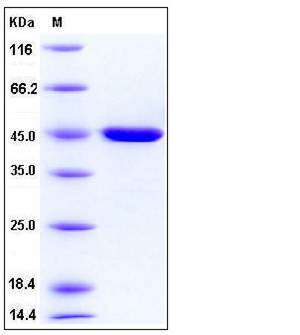Human Carboxypeptidase B1 / CPB1 Protein (His Tag)
CPB,PASP,PCPB
- 100ug (NPP1970) Please inquiry
| Catalog Number | P10501-H08H |
|---|---|
| Organism Species | Human |
| Host | Human Cells |
| Synonyms | CPB,PASP,PCPB |
| Molecular Weight | The recombinant human CPB1 consists of 413 amino acids and has a predicted molecular mass of 47 kDa. In SDS-PAGE under reducing conditions, it migrates as an approximately 45 kDa band. |
| predicted N | His 16 |
| SDS-PAGE |  |
| Purity | > 98 % as determined by SDS-PAGE |
| Protein Construction | A DNA sequence encoding the human CPB1 (NP_001862.2) (Met 1-Tyr 417) was expressed with a C-terminal polyhistidine tag. |
| Bio-activity | Measured by its ability to cleave a colorimetric peptide substrate, Hippuryl-Arg, as measured using the wavelength at 254 nm. The specific activity is >10000 pmoles/min/μg. |
| Research Area | Immunology |Innate Immunity |Coagulation |Regulatory |
| Formulation | Lyophilized from sterile 25mM MES, 0.1 M NaCl, pH 6.5 1. Normally 5 % - 8 % trehalose, mannitol and 0.01% Tween80 are added as protectants before lyophilization. Specific concentrations are included in the hardcopy of COA. |
| Background | Human Carboxypeptidase B1, also well known as pancreatic procarboxypeptidase B (PCPB), is a highly pancreas -specific protein (PASP), and has been identified previously as a serum marker for acute pancreatitis and pancreatic graft rejection. As the prototype for those human exopeptidases that cleave off basic C-terminal residues, CPB1 specifically cleaves the C-terminal Arg and Lys residues with a preference for Arg. The B1 and B2 forms of procarboxypeptidase B differ from each other mainly in isoelectric point.The deduced amino acid sequence of PCPB predicts a 416-amino acid preproenzyme consisting of a 15-aa signal peptide, a 95-aa activation peptide and a 307-aa mature chain. The secreted PCPB zymogen is converted to enzymatically active CPB1 by limited proteolysis by trypsin. |
| Reference |
